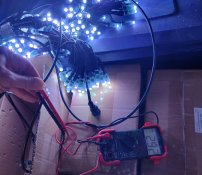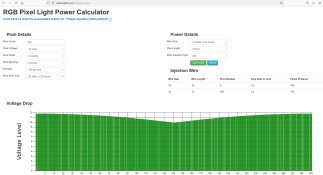SarahD
Mersey Christmas Lights, maker and breaker
Mark, can I interpret that as saying I can run pixels off a single power input until I exceed 7.5A (wire safety rating for 18AWG I think), or the voltage drops to 6.7V using the Spiker lights calculator? http://spikerlights.com/calcpower.aspx. Regulated pixels are 0.64W, and effective wire gauge is 23 AWG (from the excellent Ni Christmas lights video atI have the data sheet for the regulator. It's 6.7v that is dropout.
No more spoilers til I film the magic smoke!
I'll ask around for a thermocouple or laser based thempature measurement device. I'll see how well they cope in hot conditions (like 35°C). Thats dependant on if I get a temperature measurement device!
View: https://www.youtube.com/watch?v=GpiZQLdzYbI&t=0s
).
When I do that calculation, voltage drop limit hits first, and for regulated pixels I get to about 110 pixels at 100% power, and out to 160 @ 50% or 210 pixels at 30% power. For resistor pixels, the calculator turns yellow (20% voltage drop and color problems) at 65, 100 and 135 pixels for the same % powers, and turns red (30% voltage drop and baaad) at 85, 130 and 170ish pixels. Their power consumption is also higher at 0.72W/p, which means they draw more from the power supply - but it's still well under the 7.5A limit.
So what does this mean for wiring my props? Noting that a safety margin above 6.7V makes sense, - I'll get better colour consistency with less power injection points with regulated pixels - you can go around 1.5 x further at 30%.
I've got a 1400 pixel matrix to plan the wiring for, and this gives me more flexibility and confidence in power injection location choices (doing 2 x 700 pixel runs on separate ports). Using the calculator, I now know I could do 2 injection points each and 200W power supplies at 35% brightness, whereas with resistor pixels, I'd have been limited to 30% and an extra injection point.
Thank you - and feedback welcome if I've got an incorrect assumption in the above. I've highlighted the numbers, as they're going to be a useful rule of thumb for me to refer back to.






